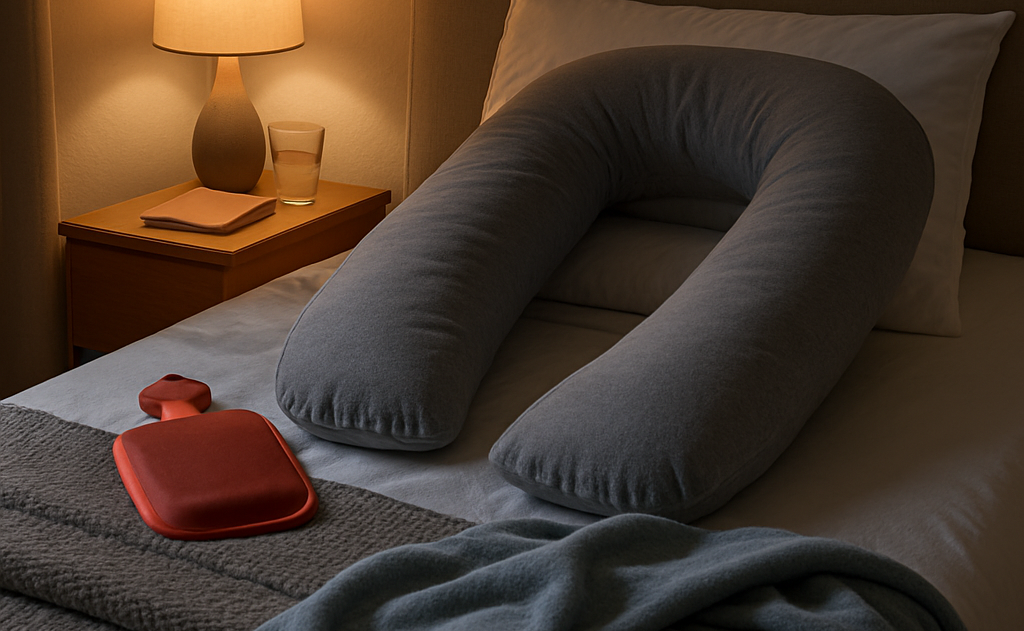
Fibromyalgia & Sleep Comfort | The Complete Guide
|
|
Tiempo de lectura 6 min
¿Tienes una cuenta?
Inicia sesión para finalizar tus compras con mayor rapidez.
|
|
Tiempo de lectura 6 min
When nights feel sensitive, small changes make a big difference. Many people living with fibromyalgia describe a tug-of-war at bedtime — pressure points complain, temperature swings feel dramatic, and getting comfortable can take longer than it should. While a pillow can’t diagnose or treat a medical issue, a full-body pillow can support gentler positioning so you move less, settle sooner, and wake up feeling less crumpled.
This guide keeps things practical: what a body pillow actually does, which shapes suit different sleepers, how to set up your bed for calmer nights, simple lifestyle adjustments, and a wind-down routine you can repeat on auto-pilot. It also links to our related deep dives so you can go further when you want to.
Sleep problems are among the most reported challenges with fibromyalgia. Pain sensitivity can make it hard to stay in one position for long, and some people describe “unrefreshing sleep,” where time in bed doesn’t translate into morning energy. This often becomes a cycle: discomfort disrupts rest, poor rest raises fatigue and stress, and higher stress can heighten sensitivity. You can’t fix everything at once — but small comfort tools (like body pillows) plus steady sleep habits give your body a better chance of restorative rest.
For a clinical overview of fibromyalgia and support pathways, see the NHS guide to fibromyalgia.
A body pillow is a simple positioning tool that works with your mattress to keep you balanced. By bringing the mattress “up” to meet you, it helps your body relax into alignment rather than fighting to find it.
Each shape balances support and space differently. Match the design to how you like to sleep and how much room you have.
Wraparound support on both sides. Great if you change sides often or prefer a more “cocooned” feel.
Targeted support with more airflow. Ideal if you mainly need hip/back alignment and like a cooler sleep environment.
Curves to support front and back together while leaving space for your usual head pillow — handy if you share a smaller bed.
Progress is often gradual; layering several small adjustments tends to add up over time.
Fibromyalgia affects the day as much as the night. Pacing activities and planning gentle breaks can prevent the “boom and bust” cycle of overexertion followed by exhaustion. Body pillows can also help during the day — for example, placing a pillow along the back of a chair for softer support, using a C-shape on the sofa during rest breaks, or choosing a compact J-shape for short naps.
These mini-rests conserve energy and can make the transition to bedtime easier since the body isn’t already over-strained from the day.
With a partner: agree a simple plan for flare-prone nights — who takes the lamp side, which pillow stays where, and when you might switch to the sofa or spare room without drama. The goal isn’t perfection; it’s minimising disruption.
Travelling: pack a compact J-shape or a smaller knee pillow and your favourite pillowcase. Hotel linens vary — familiar textures can make a surprising difference.
Plan B: some nights need “good enough.” Keep a lightweight throw, earplugs, and water within reach so small annoyances don’t become big wake-ups.
We’ve created focused guides to help you personalise your setup. Dive deeper into positioning, pillow choices, and night comfort here:
Many people find that full-body support reduces twisting and spreads contact more evenly, which can make it easier to relax into a side-sleeping position. It’s a comfort tool, not medical advice.
U-shape for maximum wraparound support, J-shape for targeted hip/back alignment and airflow, C-shape if you want a balance of front-and-back support while using your own head pillow.
Place a section between knees and ankles to keep hips stacked, hug the upper section to soften shoulder tension, and add a small roll behind the waist if your lower back likes support.
Breathable cotton or smooth microfibre covers are popular. If you run warm, try lighter bedding layers and keep a spare pillowcase to swap at night.
Wraparound designs can feel warmer for some people. Choose breathable covers, use lighter bedding, and consider J-shape designs for more airflow.
Most people notice changes within a week. At first it may feel bulky, but with consistent use your body learns to relax into the support.
Not necessarily. Comfort-focused body pillows can be suitable if they provide even support and use breathable fabrics. The right shape for your sleep style matters most.
No. A body pillow is a comfort tool. Use it alongside your healthcare advice, lifestyle adjustments, and any treatment plan recommended by your clinician.
No. These are comfort-focused ideas. For personalised care, speak to your GP or specialist team. See also the NHS fibromyalgia overview.